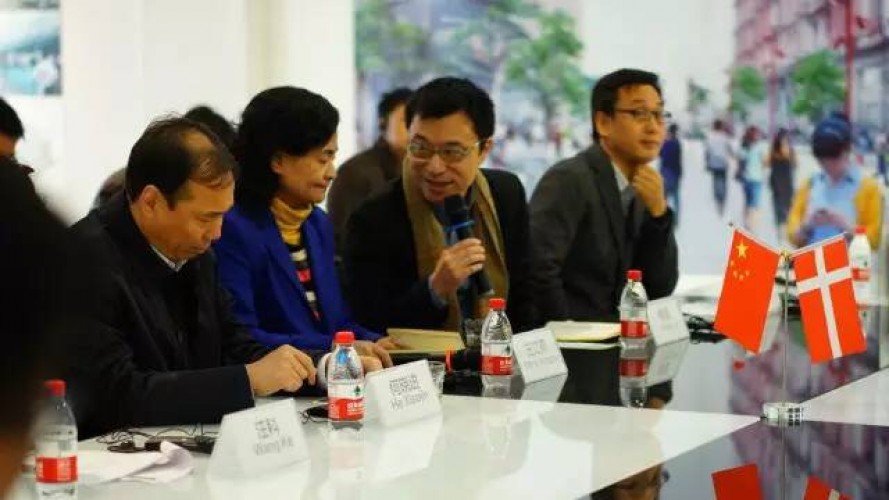Changing Mindsets: Jan Gehl at Danish Cultural Center in Beijing

On the occasion of the official Chinese launch of his book How To Study Public Life, Architect Jan Gehl visited Danish Cultural Center in Beijing to speak about the necessary change of mindsets in city planning.
In more than 50 years Gehl has advocated a sensible approach to improving urban design on the basis of human scale. In Gehl’s thinking, the human scale concerns all the activities that we undertake in public life. They are either necessary, optional and/or social activities.
Necessary activities being the domestic tasks, that we must undertake in everyday life. Optional activities are what we choose to do if the conditions are favorable, and social activities develop as a result of people undertaking necessary and optional activities being in the same place.
These three kinds of activities occur in a finely interwoven pattern, and intertwine in all conceivable combinations and allow for contact and encounters at many different levels. In the way you enter a theatre with the expectation of experiencing a dramatic performance, good urban space adds to the vitality and interest of a street, and provides constant distractions that in turn creates other forms of activities or interactions.
On the occasion of the Chinese launch of his book How To Study Public Life, Jan Gehl gave a lecture on, how changes to the physical environment can impact on the sustainability, liveability and quality of life of city dwellers.
The lecture and book launch took place on Saturday 29 October, 2016, from 14.00 at Danish Cultural Center in Beijing. People visiting Danish Cultural Center had the possibility to purchase a freshly printed copy of How To Study Public Life in the stand of China Architectural and Construction Press.
In 1971 Gehl’s influential book Life Between Buildings was published in Danish, with the first Chinese translation published in 2002. Since then, Gehl has published the following books in Chinese: Public Spaces Public Life, 2003, New City Spaces, 2003, and Cities for People, 2010 and now How To Study Public Life, all on China Architectural and Construction Press.
Danish Cultural Center is hosting two concurrent exhibitions celebrating Jan Gehl: ‘Changing Mindsets’ on Jan Gehl’s 50 years of research and methodology for improving cities, and ‘Changing Cities in 5 Steps‘ on Gehl’s work in China.


Forum on Urban Design: Changing the Mindset
Together with the Royal Danish Embassy, and Energy Foundation, China Sustainable Transportation Center, Danish Cultural Center held a forum on ‘Strengthening the Human Approach in Urban Planning and Development’.
The forum took place on Monday October 31, 2016, at Danish Cultural Center in 798 Art District, Chaoyang District.
Jan Gehl is today one of the most influential thinkers in contemporary urban design, he advocates a sensible approach to improving urban design on the basis of human scale: systematically documenting urban spaces, making gradual incremental improvements, then documenting them again.
The aim of the forum was to exchange views and experiences on how changes to the physical environment can impact on the sustainability, liveability and quality of life of city dwellers.
Since 2008, Gehl has collaborated with Energy Foundation, China Sustainable Transport Centre on case studies in a number of Chinese cities to implement the concept of ‘Cities for People’ and the spin-off in terms of better life quality for the citizens.

Changing Mindsets
The exhibition Changing Mindsets focuses on Jan Gehl’s seminal work as a theorist, researcher and writer of human behaviour in an urban context. Gehl’s approach is explicitly humanist and pro-urban, always emphasizing that cities must be designed for people rather than purely for logistic purposes, architectural bravura, or blind, simplistic economics. Good architecture is not just about form but about the interaction between form and life.
Throughout his career, Gehl has consistently developed his theory and methodology in an iterative process: testing in practice, systematically documenting, making gradual incremental improvements, then documenting them again. From Life Between Buildings in 1971 to the latest publication How to Study Public Life in 2013, his writing has gradually expanded as more research, experience, and examples from cities all over the world have been accumulated and integrated into the overall story on how to practice people-oriented architecture and planning that respects the human scale.
No matter culture, cities are places for human encounters, so their design must above all be about facilitating such opportunities. Cities should maximize the diversity of social exchange while minimizing travel needs, enabling people to enjoy life in public spaces, creating chances for people to meet accidentally and intentionally.
According to the British architect, Lord Richard Rogers, ”no one has examined the morphology and use of public space to the extent that Jan Gehl has. Anyone who reads his books will get a valuable insight into his astonishingly perceptive understanding of the relationship between public spaces and civic society, and how the two are inextricably intertwined.”
The exhibition has been organized by Danish Cultural Center in close corporation with Gehl Architects and Jan Gehl personally, Bogværket, Margrethe Mokrzycki, China Architectural and Building Press, and Feng Jing of The Paper.



